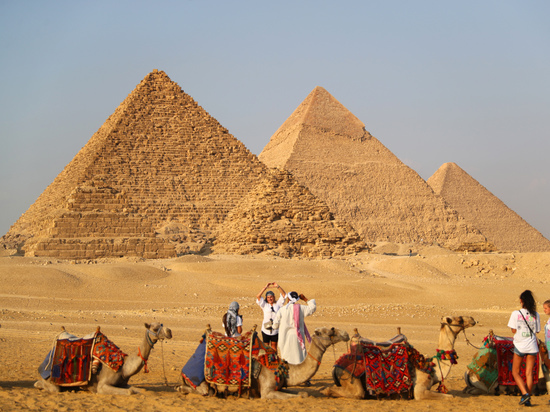The mystery of the construction of the Great Egyptian Pyramid at Giza solved
[ad_1]

How the Great Pyramid at Giza in Egypt was built was a mystery for centuries. Some theories suggest that its builders transported 2.3 million stone blocks hundreds of kilometers overland. However, a new study has found evidence to support the idea that workers used the Nile to transport giant rocks down the river, some of which weighed 15 tons.
New evidence suggests a long-lost Nile bed known as the Khufu arm flowed near where the Great Pyramid of Giza is and was used to transport 2.3 million stone blocks for building structures before the waterway dried up. around 600 BC
As writes Daily Mailthis discovery is supported by a papyrus text over 4,000 years old that describes boats using the Nile to move blocks from the rocks opposite Giza and from the Red Sea coast to build pyramids.
A team of French researchers working with researchers from China and Egypt analyzed the rock layers surrounding the pyramids, allowing them to see the timeline and the course of the Khufu arm to determine that the river levels were once high enough to reach Giza.
According to the researchers, without this arm of the Nile, it would have been impossible to build the pyramids 4,000 years ago, since the ancient Egyptians would have had to transport blocks, some of which weighed 15 tons, 500 miles overland.
The Great Pyramid of Giza, the oldest and only surviving of the Seven Wonders of the Ancient World, was built by three pharaohs from around 2550 to 2490 BC. But how exactly this happened is considered one of the world’s greatest mysteries.
Archaeologists now believe that the construction was made possible by the use of boats that traveled along the now-vanished branch of the Nile.
The team used pollen-derived vegetation samples to reconstruct 8,000-year-old river variations in the Giza floodplain.
River flow is a flow-related process in which weathered sediments are taken up by flowing water and moved to new locations, providing clues to where bodies of water may once have flowed.
The team also looked at evidence of marsh plants that grow on soft, wet ground and along lake edges, and found that the Khufu Arm has remained high in the area for quite some time, according to Phys.org.
The study also showed that the port, used to transport stone blocks thousands of years ago, is more than four miles west of the Nile – much closer than 500 miles by land.
“Our results show that the waterscapes of Giza responded to the gradual drying of East Africa caused by insolation, with the lowest levels of the Nile recorded at the end of the dynastic period,” the scientists write in a study published in PNAS. “The Khufu branch remained during the reigns of Khufu, Khafre and Menkaur, facilitating the transportation of building materials to the Giza pyramid complex.”
The pyramids are made up of 2.3 million blocks of limestone and granite, weighing an average of about 2.5 tons each. However, it is believed that the stones were first cut and then brought to the site.
The ancient Greek historian Herodotus, who lived from 484 to 425 BC, wrote that it took 20 years and the work of 100 thousand people to complete the construction of the wonder of the world. However, archaeologists claim that in reality the builders were about 20 thousand people.
The mummified remains and treasures once buried in the pyramids have been stolen by grave robbers, and the peaks have since collapsed – gigantic structures much smaller than when they were first built.
However, millions of people flock to Egypt to admire this miracle.
For over 4,500 years, the Egyptian pyramids kept their secrets deep within the maze of passages and chambers that lay within their towering stone structures. But the longstanding debate about whether the Great Pyramid of Giza hides a network of previously unknown tunnels behind its stone walls now has an answer. The researchers confirmed the find by using cosmic particles known as muons to scan the Great Pyramid of Giza. They used scanning to create maps that reveal the internal structure of the 146-meter pyramid.
Last year, thermal scans revealed a major anomaly in the Great Pyramid, the largest and oldest of the Giza pyramids and one of the Seven Wonders of the Ancient World. These scans revealed three nearby rocks at its base that were hotter than the others.
This led to the theory that they may be hiding a secret room that has yet to be discovered. A group of experts then launched the ScanPyramid project to use muons, tiny subatomic particles normally produced when cosmic rays collide with atoms on Earth, to peer through the pyramid’s huge stone blocks, some of which weigh up to 15 tons.
Renowned Egyptian archaeologist and former Egyptian Minister of State for Antiquities, Dr. Zahi Hawass, has been skeptical in the past about the usefulness of such a scan. He recently took a public stand against British Egyptologists over their theory that a secret burial chamber might be hidden behind the walls of Tutankhamun’s tomb in his tomb in the Valley of the Kings.
[ad_2]
Source link








